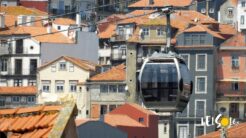Lisbon, the capital city of Portugal, has been becoming more and more popular among the tourists as of late. What to see in Lisbon? Which attractions, the city has to offer, are the best? Here’s our list of, in our opinion, the best tourist attractions and monuments you should certainly visit on your trip to Lisbon.
Hieronymites Monastery in Belem
We start off with the magnificent Hieronymites Monastery (also referred to as the Jerónimos Monastery) in the Belem parish. It was erected in a classic Manueline style in 1501 – 1551, although the building got properly finished only after a hundred years or so. The monks have inhabited the monastery till 1833. The monastery is not only a place of big spiritual, but also of historical and political importance. Many representatives of Portugal were buried here, including Manuel I and Maria of Aragon. When it comes to politics, the Treaty of Lisbon was signed in this monastery. The entry cost for the monastery is 10 EUR.
Torre de Belem – Belem Tower in Lisbon
If you’ve ever looked at sets of holiday photos from Lisbon, it’s almost certain, that the famed Belem Tower was there. Near the aforementioned monastery, stands the magnificent tower from 1520, which was ordered by Manuel I the Fortunate. It wasn’t really built for defensive purposes, but rather to showcase the sheer might of Portugal and to have it be a unique gateway to Lisbon. The tower was built by Francisco de Arruda. The construction reaches 35 metres of height, and is in fact available for visiting. The ticket costs 6 EUR.
Ajuda Palace
Ajuda Palace, built in a neoclassical style, stands where a royal residence used to stand, ordered by King John V of Portugal. It was destroyed by an earthquake in 1755. Initially, Manuel Caetano de Sousa was responsible for the palace’s project, then José da Costa e Silva and Francisco Xavier Fabri took over. There were many problems with the build, mainly the French occupation. Ajuda Palace finally opened in 1795, although it wasn’t properly finished until the next century. For some time, it functioned as a royal residence. There are many monumental exhibits, precious art pieces and beautiful halls inside the palace. Tourists can access the ground floor and the stateroom. The ticket costs only 5 EUR.
Museu Nacional do Azulejo
One of the characteristic elements of Portugal are the azulejo tiles. The city most often associated with azulejo is Porto, but it’s Lisbon that has a dedicated National Museum of the Azulejo, functioning since 1965. It was established inside the Madre de Deus monastery, from 1509. Inside the museum, we can see some lovely examples of the use of ceramics for interior decoration. The Lisbon collection is the biggest of its kind in the world. It also presents the history of the Portugal ceramics, beginning in the 16th century, up until our times. Entering the museum is not too pricey, at 5 EUR.
Miradouro das Portas do Sol viewpoint
The Largo Portas do Sol street is one of the most popular places for tourists to include in their photo sets. All thanks to the Miradouro das Portas do Sol viewpoint, from which you can admire the beauty of the Portugal panorama, alongside Lisbon’ oldest district – Alfama, and many other monuments. It’s certainly one of the must-visit places in Lisbon.
São Jorge Castle
The São Jorge Castle is not only one of the most beloved viewpoints, it’s also one of the oldest buildings in the city. This fortress was erected in the early 12th century. In 1147, the castle had already lost its original inhabitants, during the Siege of Lisbon. Over the long years, the castle had played both a militarian and a representative role. For the most part, the castle’s construction got pretty devastated, but since the second half of the 20th century, the have been efforts to reconstruct the castle. The fortress is accessible for the tourists, and there are three different tour variants, costing 16, 18 and 24 EUR respectively.
Carmo Convent (Convento da Ordem do Carmo)
Usually, guides presenting the popular attractions tend to focus on the buildings which are not falling apart. Well, this one’s an exception. The roofless monastery, located in the historic centre of Lisbon, is quite frankly a ruin. This sacred building was destroyed in 1755, and is a ‘living’ remainder of the earthquake. The monastery, built in a gothic style, was probably established somewhere between 1389 and 1423 and is now home to the Archeological Museum. The main nave, the apse and the old chapel were converted to the museum. For video game enthusiasts, the place may be familiar, as it appears in Assassin’s Creed: Rogue. Visiting the Museu Arqueológico do Carmo costs only 4 EUR.
‘Sé’ Cathedral in Lisbon
Se de Lisboa is one of the oldest buildings in the city, the oldest church in all of Lisbon, in fact. The cathedral was raised in 1150, originally in a romanesque style, but currently it represents a mix of various styles, due to the rococo insides and the necessity for a rebuild after earthquakes. A keen eye will spot some baroque and gothic touches here and there. Prior to the cathedral, a maori mosque stood in this place. Ever since the 1910, this building has been regarded as the national monument of Portugal.
Sao Roque Church in Lisbon
The Sao Roque church was one of the most beautiful temples we’ve ever seen. It’s one of the very few buildings in Lisbon which handled the 1755 earthquake well. The works on the church started in 1506, and it was properly finished in 1619. Apart from the incredible decorative ceramic tiles or the main altar, there are also 8 magnificent chapels. We feel that this temple, designed by Affonso and Bartolomeu Álvares, is certainly the most beautiful sacred place in the city.
Prazeres Graveyard
To get to know the city well, it’s often not enough to just visit the churches and the palaces, but also the graveyard. In Lisbon, even the burial place, Prazeres graveyard, is quite famous. Its history dates back to the 1833 and the times of the Cholera epidemic, which had invaded the city. The necropolis is not very comparable to the standard we’re all used to, so it’s certainly an experience worth having. Many renowned artists and politicians were buried here. There’s also the Pedro de Sousa Holsteina Mausoleum located in the graveyard, which is worth checking out.
Lisbon Oceanarium
Time for something less ancient. The Lisbon Oceanarium was established in 1998, and is the biggest of its kind in all of Europe. It holds an astounding amount of 450 different marine animal species, over 16 thousand specimens. The building itself was designed by Peter Chermayeff, and his vision was to form it like an aircraft carrier. There are both living animals and permanent exhibitions inside the oceanarium. Visiting it is certainly not of the cheapest kind. The ticket valid for visiting both the permanent and the temporary exhibition costs 19 EUR, while if you’re only interested in the permanent ones, you can pay 16.
National Pantheon of Lisbon
The National Pantheon of Lisbon is situated inside the Santa Engracia Church from the 17th century. The object was rebuilt many times. The National Mausoleum was planned as far back as in 1836, but then it wasn’t properly decided as to where it’ll be located. It was only in the 20th century, when the Santa Engracia church was chosen. Nowadays, many important national representatives are buried here, ranging from musicians, sportsmen, writers, politicians and, symbolically, Portuguese explorers. The Pantheon also serves as a viewpoint. The place is visited by over 150 thousand people every year. Entry cost’s merely 4 EUR.
Commerce Square (Praça do Comércio)
To finish off, we’ve got one of the most popular places for tourists to swarm in Lisbon. The Commerce Square takes up 35 000 m2. Its history supposedly starts after the 1755 earthquake. It’s adjacent to the Tag river, the Rua Augusta promenade and the Triumphal Arch. In the middle of the square, there’s a statue of Joseph I of Portugal from the 1755. As you would imagine, there are also many gastronomic points and shops around the square. Every year, crowds gather around the square for the Portugal Day.






